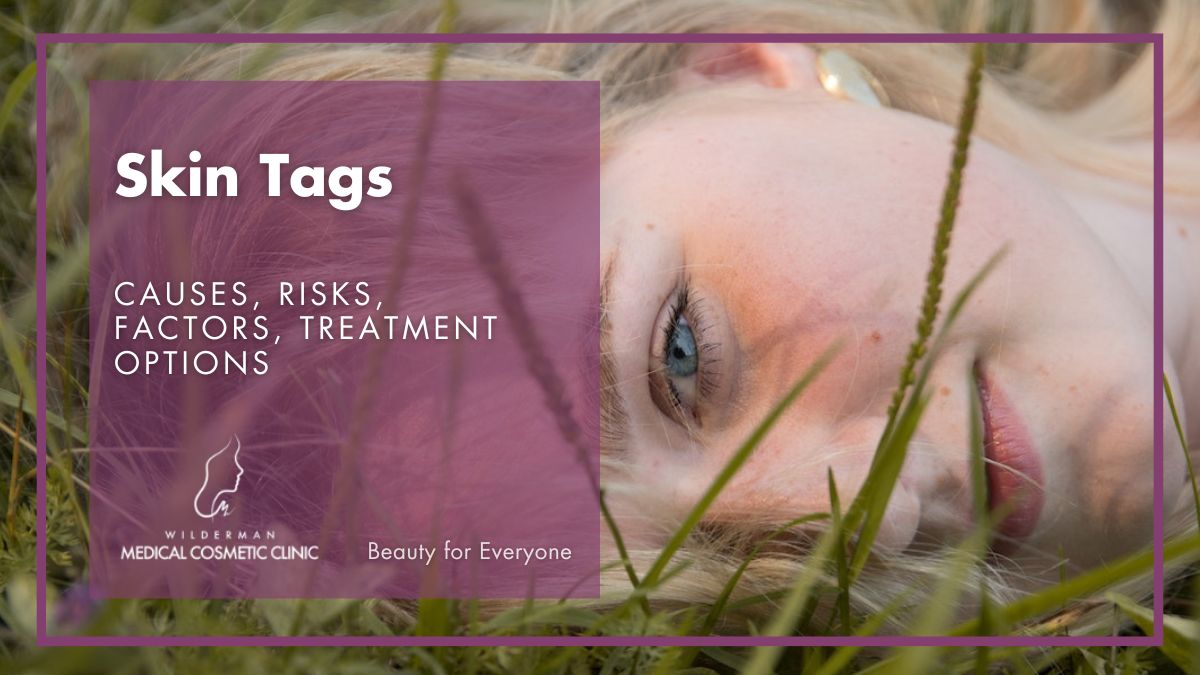What are Skin Tags?
Tiny Fleshy Growth or Health Concern?
Skin tags, also known as acrochordons, are harmless, soft, fleshy growths that hang off the skin’s surface.
They often occur in areas where skin rubs against skin, such as the neck, underarms, eyelids, groin, and breasts.

Skin tags are composed of collagen fibers and blood vessels, and their size can range from a few millimeters to a few centimeters.
How Common are They?
Skin tags are quite common in the general population.
Studies have indicated that skin tags affect approximately 50% of people (Pandey and Sonthalia,2022).
They can occur in individuals of all ages, although they are more commonly observed in middle-aged and older individuals.
Skin tags can develop in both men and women, and they are not limited to any specific ethnic group or geographical region. While skin tags are generally harmless, their prevalence highlights the need for awareness and understanding of their causes, risk factors, and available treatment options.
What are the Causes?
The exact cause of skin tags is not fully understood, but several factors may contribute to their development. These factors include:
- Friction and Skin Rubbing: Skin tags are more likely to develop in areas where the skin experiences constant friction or rubbing. Common sites include areas where clothing or jewelry may repeatedly rub against the skin, such as the neck, underarms, groin, and eyelids. Skin-to-skin friction in body folds, such as under the breasts or in the folds of the abdomen, can also contribute to the formation of skin tags. The friction and irritation caused by these repetitive actions can stimulate the growth of skin cells and collagen, leading to the formation of skin tags.
- Genetic Predisposition: There is evidence to suggest that genetics plays a role in the development of skin tags. Skin tags often run in families, indicating a possible hereditary component. If your parents or other family members have skin tags, you may have a higher likelihood of developing them as well. The specific genes associated with skin tag formation have not been identified yet, and further research is needed to understand the genetic mechanisms involved.
- Hormonal Changes: Fluctuations in hormone levels can influence the occurrence of skin tags. Hormonal changes during pregnancy, for instance, may increase the likelihood of developing skin tags. The exact reasons behind this association are not well understood, but it is believed that the hormonal shifts during pregnancy can affect the growth and development of skin cells, contributing to the formation of skin tags. Additionally, individuals with hormonal imbalances, such as those with conditions like polycystic ovary syndrome (PCOS), may have a higher risk of developing skin tags due to the hormonal disruptions they experience.
Risk Factors for Skin Tags
Some of the common risk factors for developing skin tags include:
- Obesity: Excess weight and obesity can contribute to the development of skin tags. Overweight individuals tend to have more skin folds and creases, providing an environment where friction and rubbing occur more frequently. The increased skin-to-skin contact and irritation in these areas make them more susceptible to skin tag formation.
- Age: Skin tags become more common as people age. While they can occur at any age, they are more frequently observed in middle-aged and older individuals. The precise reasons for this age-related increase in skin tags are not fully understood, but it may be related to a combination of factors such as hormonal changes, collagen changes, and cumulative skin damage over time.
- Diabetes: Studies have suggested a possible association between diabetes and the occurrence of skin tags. It is believed that the underlying insulin resistance or metabolic changes in diabetes may contribute to the development of skin tags. However, the exact relationship between diabetes and skin tags requires further research to be fully understood.
- Hormonal Imbalances: Hormonal imbalances, such as those seen in conditions like PCOS, may increase the likelihood of developing skin tags. PCOS is characterized by hormonal disturbances, including high levels of insulin and androgens (male hormones), which may contribute to the growth of skin tags.
It is important to note that while these factors may increase the likelihood of developing skin tags, not everyone with these risk factors will necessarily develop them. The exact interplay of these factors and the formation of skin tags requires further research.
Treatment Options for Skin Tags
When it comes to treating skin tags, it’s important to note that most skin tags are harmless and do not require medical intervention. However, if a skin tag is causing discomfort, irritation, or cosmetic concerns, there are several treatment options available.
The common treatment options for skin tags include:
- Surgical Removal: This is a common method for removing skin tags. It involves an aesthetic physician or healthcare professional using a scalpel, scissors, or a medical device to cut off the skin tag at its base. Local anesthesia may be used to numb the area before the procedure. This method is generally quick, and stitches are usually not required. Some minor bleeding may occur, but it can be controlled with gentle pressure.
- Cauterization: In this procedure, the skin tag is burned off using heat or electricity. The healthcare professional may use a specialized instrument, such as a cautery pen, to deliver controlled heat or electric current to the base of the skin tag. This effectively burns the tissue and stops any bleeding. Cauterization is a relatively quick procedure that may require local anesthesia.
- Cryotherapy: Cryotherapy involves freezing the skin tag using liquid nitrogen. The extremely cold temperature destroys the cells within the skin tag, causing it to wither and fall off. This method is commonly used for smaller skin tags. The procedure may cause some discomfort, but it is generally well-tolerated. Multiple sessions may be required for larger skin tags.
- Ligation: This method involves tying off the base of the skin tag with a sterile thread or dental floss. By restricting the blood supply to the skin tag, it eventually dries out and falls off. Ligation is a relatively simple procedure that can be done at home or under medical supervision. It may take several days or weeks for the skin tag to detach naturally.
- Over-the-counter Solutions: There are over-the-counter products, such as creams or solutions, that claim to remove skin tags. These products usually work by drying out the skin tag over time. However, the effectiveness of these products can vary, and it is advisable to consult with a healthcare professional before using them.
It is worth noting that home remedies or attempting to remove skin tags by yourself using non-sterile tools or methods can lead to infection, scarring, or other complications. It is always recommended to seek professional medical advice for proper evaluation and treatment of skin tags.
Take Away
Skin tags are benign growths that are prevalent among individuals of various age groups. While they pose no medical risk, they can cause discomfort or self-consciousness.
Understanding the causes, risk factors, and treatment options for skin tags can help individuals make informed decisions about managing them. If you have concerns or questions about skin tags, it is advisable to consult an aesthetic physician or skincare professional who can provide personalized guidance and recommend the most appropriate treatment approach for your specific situation.
Reference
Cleveland Clinic. Skin Tags (Acrochordons). Retrieved from https://my.clevelandclinic.org/health/diseases/21528-skin-tags-acrochordons. Accessed on June 5, 2023.
National Center for Biotechnology Information. Skin Tags (Acrochordon). In: StatPearls [Internet]. Treasure Island (FL): StatPearls Publishing; 2023 Jan-. Available from: https://www.ncbi.nlm.nih.gov/books/NBK547724/. Accessed June 5, 2023.
NHS. Skin Tags. Available from: https://www.nhs.uk/conditions/skin-tags/. Accessed June 5, 2023.
American Academy of Dermatology. Skin Tags. Available from: https://www.aad.org/public/diseases/a-z/skin-tags. Accessed June 5, 2023.
Other skin conditions that may be of interest
Skin Laxity: A common skin concern – Skin laxity is a common concern that many individuals experience as they age. It is characterized by a loss of firmness, elasticity, and resilience in the skin, leading to a less …
Sagging Skin – As we age, one of the most common concerns we face is sagging skin. The loss of elasticity and firmness can affect various parts of our body, including the face, neck, arms, and abdomen. Sagging skin can be attributed to …
Stretch Marks: Causes, Treatments, Prevention – Stretch marks, also known as striae, are a common skin condition that affects both men and women. They often appear as visible lines on the skin, typically on …
Spider Veins and Broken Capillaries – Spider veins and broken capillaries are common vascular conditions that affect a significant number of people. While they are typically harmless, they can cause cosmetic concerns for …
Oily Skin – Oily skin is a common dermatological condition characterized by excess sebum production, which can lead to a shiny, greasy appearance and potential skin issues such as acne breakouts and clogged pores. While it can be …
Smoker’s lines: A real connection to smoking? – Smoker’s lines, also known as lip lines, lipstick lines, or perioral wrinkles, are fine lines that develop around the mouth and lips. These lines can be unsightly and may contribute to …
Acne Scarring: Causes, Treatment, Prevention – Acne is a common skin condition that affects millions of people worldwide, causing physical and emotional distress. In some cases, acne can leave behind unsightly scars, further impacting …
Dark Under-Eye Circles – Dark under-eye circles can be frustrating and make you appear tired or older than you actually are. They are a common cosmetic concern that affects people of all ages. We will explore what …
Stay Ahead of the Beauty Curve
Beyond Beauty: Elevate Your Routine with Insider Tips and Breakthroughs – Subscribe Now!
Transform your beauty routine into something extraordinary!


